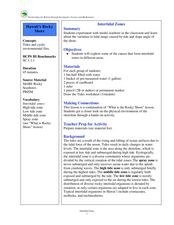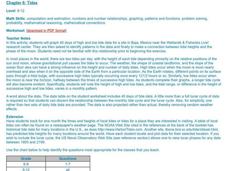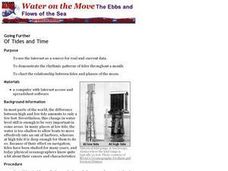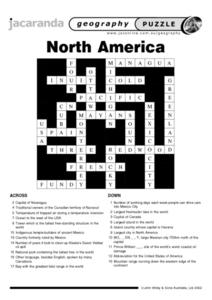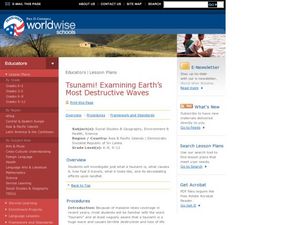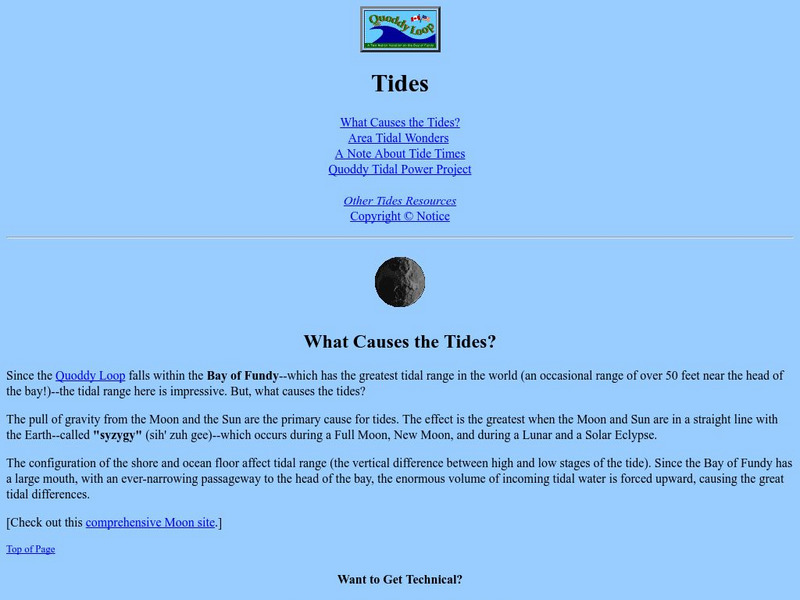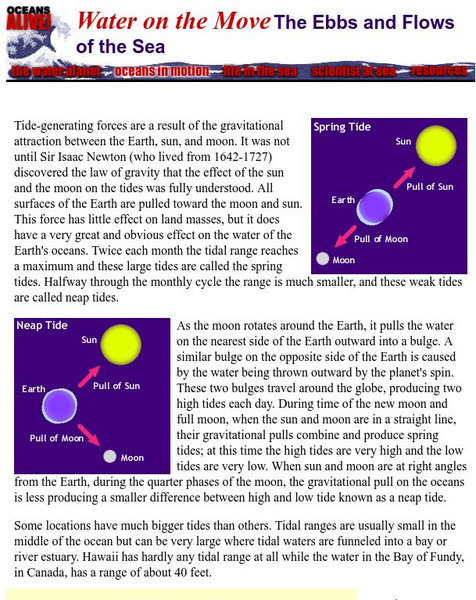Tidal Range Teacher Resources
Find Tidal Range lesson plans and worksheets
Showing 27 resources
Curated OER
How Does the Moon Affect Tidal Range?
Eighth graders study the phases of the moon. In this tides lesson students use the Internet to retrieve information.
Curated OER
Ocean Waves and Tides
In this tides worksheet, students will use a tide chart to plot 15 data points onto a graph. Students will be looking at high tides and low tides and comparing the ranges. This worksheet has 2 short answer questions.
MinuteEarth
Tidal Locking—Why Do We Only See One Side of the Moon?
Turn to the dark side ... of the moon, that is! Young space explorers learn why the dark side of the moon is never visible here on Earth in an animated video. The resource shows how the moon formed, its dizzying early orbiting pattern,...
Curated OER
Intertidal Zones
Students explore intertidal zones. In this intertidal zones lesson plan, students work in small groups and use ready-made materials to create a model of intertidal zones. Resources are provided.
Curated OER
The Effect of Tides & Elevation on Wetland Plant Communities
Students comprehend how tides can impact shoreline plant communities through the study of a freshwater tidal marsh. They use actual tidal data to show that tidal ranges differ among geographic locations, even those relatively close...
Curated OER
Hurricane and Weather Power Points
Providing a wealth of information about hurricanes, tornadoes, and other types of weather-related events, this resource could be used in the classroom in a variety of ways. A teacher could use the PowerPoints listed as a way to introduce...
Curated OER
Tides
Students graph 40 days of high and low tide data for a site in Baja, Mexico near the Wetlands & Fisheries Live! research center. They identify patterns in the data and finally to make a connection between tidal heights and the phase...
Curated OER
North America Puzzle
In this geography worksheet, students complete a crossword puzzle in reference to North America. They identify capitals of some countries, the specific landforms of different areas, and languages spoken. There are 21 clues to solving the...
Curated OER
Marine Biology - The Story of Waves
When teaching about the movement of water in the ocean, this PowerPoint will be a terrific support. It covers how waves break and how they are generated. The causes of tides and tsunamis are also detailed. A couple of changes could make...
Curated OER
Ocean Waves and Tides
Except for a few blurry photos that you can leave out, this is a succinct, yet purposeful presentation. It explains what causes ocean waves, the parts of a wave, and how they break against a shore. It details the cause of tides and...
Curated OER
Of Tides and Time
Students use the internet to research how the time of day affects the tides. They work together to develop a demonstration of the tide patterns for a month. They create a chart showing the relationship between tides and the phases of...
Curated OER
North America Puzzle Answer Sheet
In this geography worksheet, students name the capitals of various countries found in North America. They also identify the various weather patterns across the continent and specific bodies of water. There are 21 descriptions and 21...
Curated OER
Tsunami! Examining Earth's Most Destructive Waves
Students investigate just what a tsunami is, what causes it, how fast it travels, what it looks like, and its devastating effects upon landfall. They read the experience of a former Peace Corps Volunteer who went to Sri Lanka after it...
Curated OER
Black Holes IV
In this black holes activity, students read about black holes and solve 3 problems where they calculate the Schwarschild radius of one, the number of grams/second a quasar luminosity implies for another and the number of suns per year a...
Curated OER
Summer Camp 2050
Students create a camp for the future. In this simulation activity, students will research various energy sources, and create a proposal for the "city council" to recommend what energy sources should be used for a summer camp in the year...
Curated OER
An Introduction to the Marine Environment and Geology of City Point: A Model for Experiential Teaching
Students begin the lesson by researching the history of City Point, Connecticut. Using a map, they color areas they were asked to find and discuss why the areas are important to the community. As a class, they are shown recent slides...
Curated OER
General Science Quiz
In this science worksheet, students write short answers for questions on planets, oceans, elements, and more. Students complete 20 questions.
Curated OER
Tsunami! Examining Earth's Most Destructive Waves.
Students discover what creates a tsunami In this earth science instructional activity, student research using the Internet how tsunami's develop. Students read accounts of first responders to the Sri Lanka tsunami.
Other
Quoddy Loop: Tides
This resource gives an in-depth description of the Quoddy Loop of Islands within the Bay of Fundy. This area has the greatest tidal range in the world. Learn what causes these massive tides.
CK-12 Foundation
Ck 12: Earth Science: Tides
[Free Registration/Login may be required to access all resource tools.] Reveals tidal patterns and that tides are caused by the gravitational attraction of the Sun and Moon to Earth.
Monterey Institute for Technology and Education
National Oceanic and Atmospheric Administration: Tides
This animation on tides is very thorough, explaining the cause of tides and the adaptations organisms must have to survive in the intertidal zone. An additional simulation will test your understanding of tides.
CK-12 Foundation
Ck 12: Earth Science: Tides Study Guide
[Free Registration/Login may be required to access all resource tools.] This study guide summarizes key points about the different types of tides and the Moon's effect on Earth's tides. Includes a few questions to check for understanding.
Museum of Science
Museum of Science, Boston: Ebbs and Flows of the Sea
A simple one-page explanation of oceanic tides. Includes instructions for completing a tide-mapping activity.
NOAA
Noaa: Our Restless Tides
This site provides an excellent explanation of the nature of tides and how they are formed. The one shortcoming is the use of the fictional "centrifugal force", but this is commonly misused in literature.





